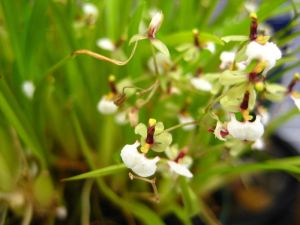No edit summary |
No edit summary |
||
| (One intermediate revision by the same user not shown) | |||
| Line 1: | Line 1: | ||
<b>Received:</b> 2024-07-10 | |||
<b>Light:</b> 15000 - 23000 lux; 1400 - 2100 foot candles | |||
<b>Temperature:</b> The average temperature of the summer day is 29 - 31℃, the night 18 - 20℃, and the daily difference is 11 - 12℃. The average temperature of the winter day is 19 - 20℃, the night 9 - 10℃, and the daily difference is 10℃ | |||
<b>Humidity:</b> In autumn and winter needs humidity of 75 - 80%, but in spring and summer it drops to 65 - 70% | |||
<b>Watering:</b> Precipitation is moderate to heavy throughout the year. The cultivated plants should often be watered during active growth, but excellent drainage should be ensured | |||
<b>Fertilisation:</b> Weekly use of 1/4 - 1/2 of the recommended dose of orchid fertiliser is recommended. You can use sustainable fertiliser throughout the year, but you can also use high-nitrogen fertiliser from spring to mid-summer, and then until the end of autumn use high-phosphoric fertiliser | |||
<b>Rest period:</b> In winter you can slightly reduce the amount of water, especially when grown in the conditions of a short, dark day in winter. The plants, however, can never dry up completely, and the pseudobulbs can not be excessively wrinkled. Fertilisation should be reduced or eliminated until spring | |||
<b>Blooming:</b> Blooms in the summer and autumn on an arching, slender, 18cm long, loosely several flowered inflorescence carrying tiny fragrant flowers. The small flowers are 0.6 - 1.0 cm long from the top of the dorsal petal to the edge of the lip. The flakes of both whorls are white to lemon-green. The lip is white with a large yellow or orange thickening. The spine is dark purple - purple | |||
[[File: Ornithophora_radicans.jpg|thumb|''Ornithophora radicans'']] | [[File: Ornithophora_radicans.jpg|thumb|''Ornithophora radicans'']] | ||
| Line 12: | Line 31: | ||
Found in South-East and Southern Brazil near the coast at elevations around 400m as a miniature sized, warm to hot growing epiphyte with thin, narrow, oblong-ligulate, compressed, ancipitous pseudobulbs subtended basally by several, distichous, leaf-bearing sheaths and carrying 2 apical, grass-like, cuneate, linear-ligulate, acute, membraneous leaves that blooms on an arching, slender, 18cm long, loosely several flowered inflorescence occurring in the summer and autumn with tiny fragrant flowers. Best grown on a slab of tree fern in warm to cool temperatures, moderate shade and kept moist year-round except for a short dry rest after the pseudobulb has matured. | Found in South-East and Southern Brazil near the coast at elevations around 400m as a miniature sized, warm to hot growing epiphyte with thin, narrow, oblong-ligulate, compressed, ancipitous pseudobulbs subtended basally by several, distichous, leaf-bearing sheaths and carrying 2 apical, grass-like, cuneate, linear-ligulate, acute, membraneous leaves that blooms on an arching, slender, 18cm long, loosely several flowered inflorescence occurring in the summer and autumn with tiny fragrant flowers. Best grown on a slab of tree fern in warm to cool temperatures, moderate shade and kept moist year-round except for a short dry rest after the pseudobulb has matured. | ||
Latest revision as of 10:05, 14 August 2024
Received: 2024-07-10
Light: 15000 - 23000 lux; 1400 - 2100 foot candles
Temperature: The average temperature of the summer day is 29 - 31℃, the night 18 - 20℃, and the daily difference is 11 - 12℃. The average temperature of the winter day is 19 - 20℃, the night 9 - 10℃, and the daily difference is 10℃
Humidity: In autumn and winter needs humidity of 75 - 80%, but in spring and summer it drops to 65 - 70%
Watering: Precipitation is moderate to heavy throughout the year. The cultivated plants should often be watered during active growth, but excellent drainage should be ensured
Fertilisation: Weekly use of 1/4 - 1/2 of the recommended dose of orchid fertiliser is recommended. You can use sustainable fertiliser throughout the year, but you can also use high-nitrogen fertiliser from spring to mid-summer, and then until the end of autumn use high-phosphoric fertiliser
Rest period: In winter you can slightly reduce the amount of water, especially when grown in the conditions of a short, dark day in winter. The plants, however, can never dry up completely, and the pseudobulbs can not be excessively wrinkled. Fertilisation should be reduced or eliminated until spring
Blooming: Blooms in the summer and autumn on an arching, slender, 18cm long, loosely several flowered inflorescence carrying tiny fragrant flowers. The small flowers are 0.6 - 1.0 cm long from the top of the dorsal petal to the edge of the lip. The flakes of both whorls are white to lemon-green. The lip is white with a large yellow or orange thickening. The spine is dark purple - purple

Code: ORPHA.0x0000, ORPHA.0x0001
Common Name: The Ground Rooting Ornithophora
Scented: yes
Light Requirements: partial shade
Temperature Requirements: intermediate to hot
Blooms: summer and autumn
Flower Size: 5mm to 1cm
Synonyms: Ornithophora quadricolor Barb. Rodr. 1881; *Sigmatostalix radicans Rchb. f. 1864
Found in South-East and Southern Brazil near the coast at elevations around 400m as a miniature sized, warm to hot growing epiphyte with thin, narrow, oblong-ligulate, compressed, ancipitous pseudobulbs subtended basally by several, distichous, leaf-bearing sheaths and carrying 2 apical, grass-like, cuneate, linear-ligulate, acute, membraneous leaves that blooms on an arching, slender, 18cm long, loosely several flowered inflorescence occurring in the summer and autumn with tiny fragrant flowers. Best grown on a slab of tree fern in warm to cool temperatures, moderate shade and kept moist year-round except for a short dry rest after the pseudobulb has matured.